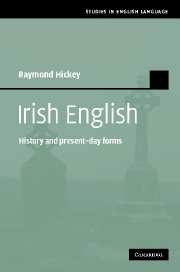4 - The emergence of Irish English
Published online by Cambridge University Press: 14 January 2010
Summary
Language shift in Ireland
The most remarkable fact in the linguistic history of Ireland since the seventeenth century is the abandonment of the Irish language by successive generations, to such an extent that the remaining Irish-speaking areas today are only a fraction of the size of the country and contain not much more than 1 per cent of the population. Bilingualism did not establish itself in Ireland, though it characterised the transition from Irish to English. No matter how long this bilingualism lasted, the goal of the shift was obvious and those who shifted to English ultimately abandoned Irish, even though this took many generations. The remaining bilinguals today are mostly native speakers of Irish in the Irish-speaking districts, all of whom also speak English. There was never any functional distribution of Irish and English, either in the towns or the countryside, so that stable diglossia could not have developed.
For external reasons, connected with employment opportunities and social advancement, the Irish relinquished their native language for that of the colonial power. The process most likely began in earnest after the defeat of the old Gaelic order by the English (Ross 1998) at the beginning of the seventeenth century (see section 2.1.4). Before that Irish was, if anything, stronger than it had been immediately after the initial invasion in the late twelfth century. The shift also shows a clear geographical distribution.
- Type
- Chapter
- Information
- Irish EnglishHistory and Present-Day Forms, pp. 121 - 295Publisher: Cambridge University PressPrint publication year: 2007



